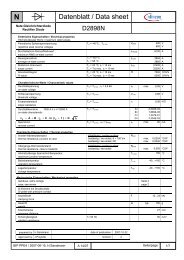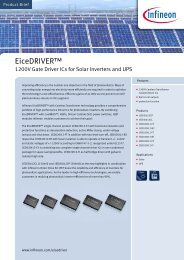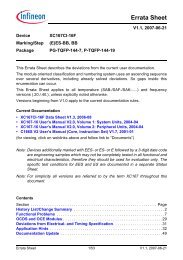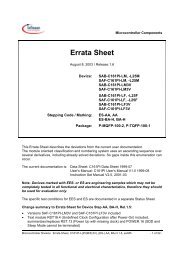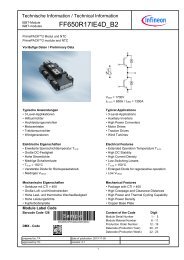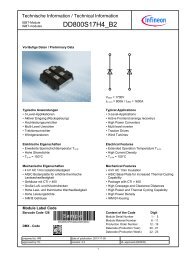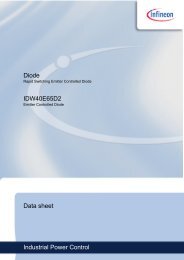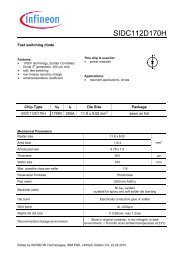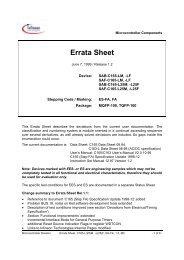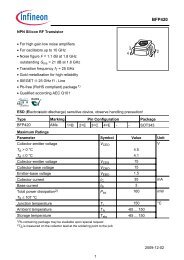Application Note CoolMOS™ CP - Infineon
Application Note CoolMOS™ CP - Infineon
Application Note CoolMOS™ CP - Infineon
Create successful ePaper yourself
Turn your PDF publications into a flip-book with our unique Google optimized e-Paper software.
CoolMOS TM <strong>CP</strong><br />
- How to make most beneficial use of the latest<br />
generation of super junction technology devices<br />
and 30 (Figure 14). The Coss-controlled dv/dt is nearly doubled for <strong>CP</strong> compared to C3. In order to avoid<br />
excessively high dv/dt values, the first<br />
recommendation is to keep the turn-off transition<br />
600<br />
in the gate controlled region under the highest<br />
load current condition occurring in the application.<br />
500<br />
For example, in a forward converter the operating<br />
current range is relatively limited, and operating<br />
870 V/ns !<br />
144 V/ns 80 V/ns<br />
current tends to be low- Coss controlled turn-off<br />
400<br />
will not result in potentially destructive dv/dt.<br />
However, in boost converters for PFC, the peak<br />
300<br />
<strong>CP</strong>, turn off at 5A<br />
current is not necessarily under direct gate<br />
<strong>CP</strong>, turn off at 10A<br />
200<br />
control, considering issues like input voltage<br />
<strong>CP</strong>, turn off at 30A<br />
transients and response delays in an average<br />
current mode controller. In that case, more care<br />
100<br />
C3, turn off at 5A<br />
C3, turn off at 10A<br />
C3, turn off at 30A<br />
must be exercised.<br />
The key to reliability under all conditions is<br />
maintaining device control. This means using gate<br />
drive to limit excessive di/dt and dv/dt by using the<br />
correct range for gate driver resistance. This is in<br />
principle no difference for CoolMOS <strong>CP</strong> than for<br />
C3. Transconductance for the two<br />
generations are actually quite similar, as the<br />
comparison in Figure 13 shows (190 mΩ C3,<br />
199 mΩ <strong>CP</strong>). What happens when gate<br />
driver resistors are chosen outside a<br />
reasonable operating range? This is<br />
examined in the context of the 199/190 mΩ<br />
<strong>CP</strong>/C3 MOSFETs in next paragraph.<br />
Drain current Ids [A]<br />
160<br />
120<br />
80<br />
Drain source voltage Vds [V]<br />
0<br />
0 5 10 15 20 25 30<br />
Time [ns]<br />
Figure 14 dv/dt simulation of <strong>CP</strong>, C3<br />
<strong>CP</strong> at Vds 20 V<br />
C3 at Vds 20 V<br />
C3 at Vds 400 V<br />
<strong>CP</strong> at Vds 400 V<br />
With very low values of gate driver<br />
resistance, di/dt is not under control of the<br />
MOSFET, but instead by the surrounding<br />
40<br />
circuit elements. This is demonstrated in<br />
Figure 15 with the gate input resistor of<br />
6.8 Ohm for an IPW60R199<strong>CP</strong>, and di/dt<br />
0<br />
that rises quite rapidly with load current, until<br />
0 2 4 6 8 10<br />
limited by external parasitic inductance. In<br />
Gate voltage Vgs [V]<br />
this case di/dt can reach thousands of<br />
amperes per microsecond. With the gate Figure 13 Transconductance characteristics of <strong>CP</strong>, C3<br />
resistor raised to 68 ohms, the picture is very<br />
different, and the rate of charging Cgs controls the di/dt independent of drain circuit loading, keeping peak di/dt in<br />
this case to a reasonable but fast 700A/µsec. A similar situation exists for controlling dv/dt, as would be expected.<br />
11 of 32



